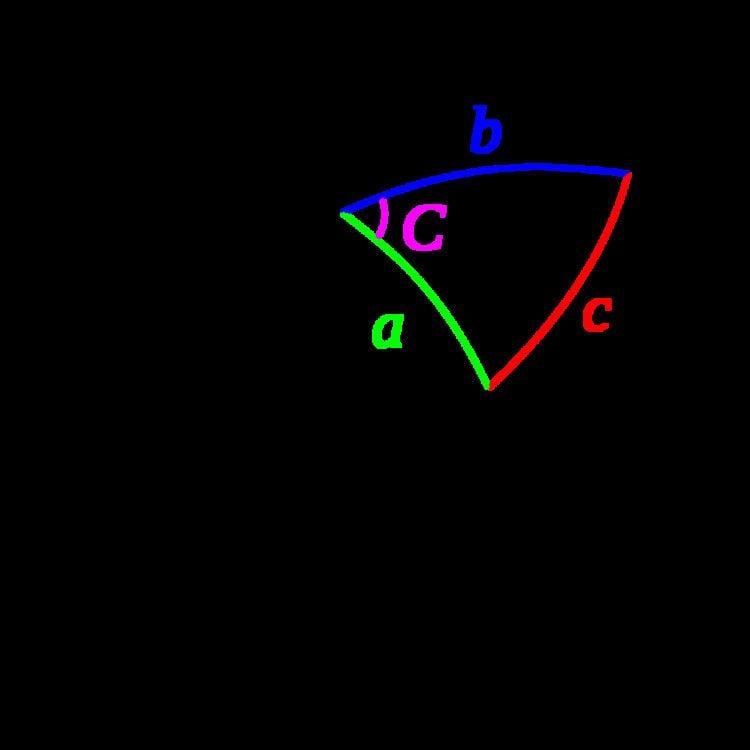 | ||
The haversine formula determines the great-circle distance between two points on a sphere given their longitudes and latitudes. Important in navigation, it is a special case of a more general formula in spherical trigonometry, the law of haversines, that relates the sides and angles of spherical triangles.
Contents
The first table of haversines in English was published by James Andrew in 1805, but Florian Cajori credits an earlier use by José de Mendoza y Ríos in 1801. The term haversine was coined in 1835 by James Inman.
These names follow from the fact that they are customarily written in terms of the haversine function, given by haversin(θ) = sin2(θ/2). The formulas could equally be written in terms of any multiple of the haversine, such as the older versine function (twice the haversine). Prior to the advent of computers, the elimination of division and multiplication by factors of two proved convenient enough that tables of haversine values and logarithms were included in 19th and early 20th century navigation and trigonometric texts. These days, the haversine form is also convenient in that it has no coefficient in front of the sin2 function.
The haversine formula
For any two points on a sphere, the haversine of the central angle between them is given by
where
On the left side of the equals sign d/r is the central angle, assuming angles are measured in radians (note that φ and λ; can be converted from radians to degrees by multiplying by 180/π as usual).
Solve for d by applying the inverse haversine (if available) or by using the arcsine (inverse sine) function:
where h is hav(d/r), or more explicitly:
When using these formulae, one must ensure that h does not exceed 1 due to a floating point error (d is only real for h from 0 to 1). h only approaches 1 for antipodal points (on opposite sides of the sphere)—in this region, relatively large numerical errors tend to arise in the formula when finite precision is used. Because d is then large (approaching πR, half the circumference) a small error is often not a major concern in this unusual case (although there are other great-circle distance formulas that avoid this problem). (The formula above is sometimes written in terms of the arctangent function, but this suffers from similar numerical problems near h = 1.)
As described below, a similar formula can be written using cosines (sometimes called the spherical law of cosines, not to be confused with the law of cosines for plane geometry) instead of haversines, but if the two points are close together (e.g. a kilometer apart, on the Earth) you might end up with cos(d/R) = 0.99999999, leading to an inaccurate answer. Since the haversine formula uses sines it avoids that problem.
Either formula is only an approximation when applied to the Earth, which is not a perfect sphere: the "Earth radius" R varies from 6356.752 km at the poles to 6378.137 km at the equator. More importantly, the radius of curvature of a north-south line on the earth's surface is 1% greater at the poles (≈6399.594 km) than at the equator (≈6335.439 km)—so the haversine formula and law of cosines cannot be guaranteed correct to better than 0.5%. More accurate methods that consider the Earth's ellipticity are given by Vincenty's formulae and the other formulas in the geographical distance article.
The law of haversines
Given a unit sphere, a "triangle" on the surface of the sphere is defined by the great circles connecting three points u, v, and w on the sphere. If the lengths of these three sides are a (from u to v), b (from u to w), and c (from v to w), and the angle of the corner opposite c is C, then the law of haversines states:
Since this is a unit sphere, the lengths a, b, and c are simply equal to the angles (in radians) subtended by those sides from the center of the sphere (for a non-unit sphere, each of these arc lengths is equal to its central angle multiplied by the radius of the sphere).
In order to obtain the haversine formula of the previous section from this law, one simply considers the special case where u is the north pole, while v and w are the two points whose separation d is to be determined. In that case, a and b are π/2 − φ1,2 (i.e., 90° − latitude), C is the longitude separation Δλ, and c is the desired d/R. Noting that sin(π/2 − φ) = cos(φ), the haversine formula immediately follows.
To derive the law of haversines, one starts with the spherical law of cosines:
As mentioned above, this formula is an ill-conditioned way of solving for c when c is small. Instead, we substitute the identity that cos(θ) = 1 − 2 hav(θ), and also employ the addition identity cos(a − b) = cos(a)cos(b) + sin(a)sin(b), to obtain the law of haversines, above.
